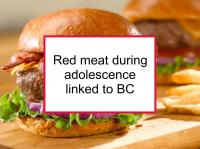Dietary and lifestyle factors influence breast cancer risk at each stage of life, including the teenage years. This gives us an opportunity to reduce the risk in our high-risk daughters and sons. Vigorous exercise during adolescence has been found to reduce the subsequent risks of both premenopausal and postmenopausal breast cancer.
Adolescent consumption of calcium-rich, vitamin D-rich, high fiber, and high carotenoid foods have all been found to reduce the risk of benign fibrocystic breast disease (which can be a precursor to breast cancer) and breast cancer itself. On the other hand, numerous factors have been identified that increase subsequent risk of breast cancer. Now a major prospective study has reported that high red meat consumption during adolescence is associated with increased risk of premenopausal breast cancer. However, substituting poultry, fish, legumes, or nuts for red meat has the potential to lower breast cancer risk.
Breast cancer risk factors during adolescence
The following lifestyle choices and exposures during the teenage years have been found to be associated with increased risk of breast cancer during adulthood:
- High or significant consumption of alcohol, butter or red meat
- Exposure to harmful chemicals (including bisphenol A (BPA), styrene, and phthalates) that can leach from plastics
- Use of personal care products and cosmetics containing parabens, placenta or hormones
- Exposure to household insecticides containing lambda-cyhalothrin
- Radiation to the chest or back
- Exposure to light during regular sleeping hours
- Cigarette smoking
- Use of birth control pills or similar contraceptives
- Use of estrogenic herbal supplements designed to regulate menstruation
- Use of pills or creams designed to increase breast size
- Working in or near auto repair shops, gas stations, chemical plants, automotive plastics manufacturing plants, textile manufacturing plants, electrical manufacturing plants, food canning operations, dry cleaners, recycling or waste disposal facilities, or military bases.
Latest research reports red meat increases breast cancer risk
The prospective study referenced at the beginning of this news story was designed to examine the associations between adolescent red meat and other protein consumption and breast cancer risk. The study included 44,231 women enrolled in the Nurses' Health Study II at ages 33 to 52 and followed for 13 years. Participants completed a detailed food questionnaire in 1998 covering diet during adolescence. The analysis was adjusted for established breast cancer risk factors. A total of 1,132 of the women were diagnosed with breast cancer during follow up.
High consumption of red meat during adolescence was associated with higher premenopausal, but not postmenopausal, breast cancer risk. When the women were divided into five groups (quintiles) according to total red meat consumption, women in the highest quintile of adolescent consumption were found to have a 42% higher risk of premenopausal breast cancer compared to those in the lowest quintile. Intakes of iron, heme iron (from meat or seafood), fish, eggs, legumes and nuts were not found to be associated with risk of breast cancer. On the other hand, poultry intake during adolescence was associated with lower risk of both premenopausal and postmenopausal breast cancer.
Further analysis demonstrated that replacing one serving of red meat per day with one serving of poultry, fish, legumes, or nuts was associated with a 16% lower overall risk of breast cancer (i.e., both premenopausal and postmenopausal) and a 24% lower risk of premenopausal breast cancer. The authors conclude that higher consumption of red meat during adolescence was associated with increased risk of premenopausal breast cancer in this population. Substituting other protein sources for red meat during adolescence has the potential to reduce premenopausal breast cancer risk, according to the authors.
Please see our articles on how to protect our teenage daughters, chicken, beef, pork, lamb and bacon for more information.
